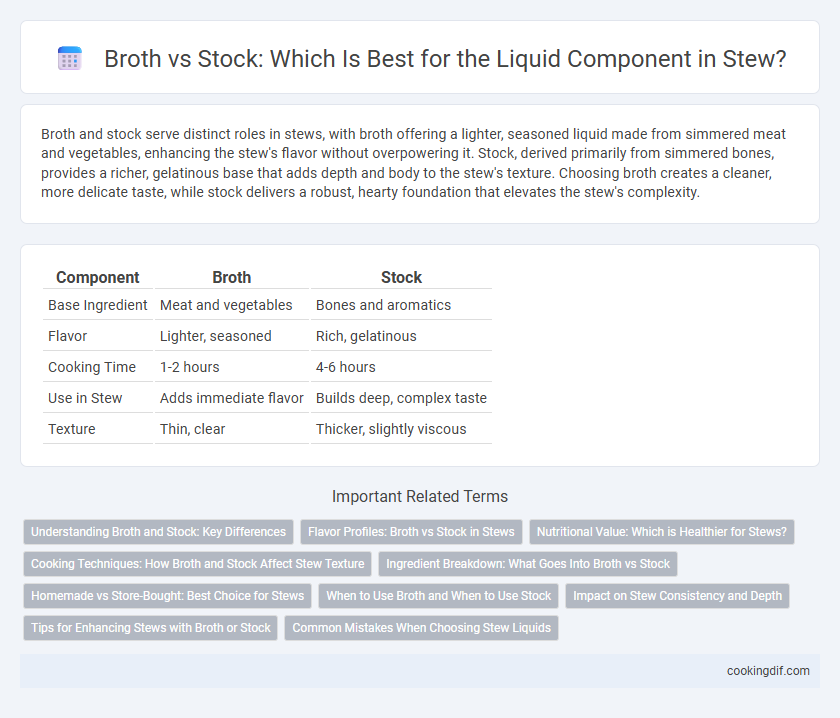Broth and stock serve distinct roles in stews, with broth offering a lighter, seasoned liquid made from simmered meat and vegetables, enhancing the stew's flavor without overpowering it. Stock, derived primarily from simmered bones, provides a richer, gelatinous base that adds depth and body to the stew's texture. Choosing broth creates a cleaner, more delicate taste, while stock delivers a robust, hearty foundation that elevates the stew's complexity.
Table of Comparison
| Component | Broth | Stock |
|---|---|---|
| Base Ingredient | Meat and vegetables | Bones and aromatics |
| Flavor | Lighter, seasoned | Rich, gelatinous |
| Cooking Time | 1-2 hours | 4-6 hours |
| Use in Stew | Adds immediate flavor | Builds deep, complex taste |
| Texture | Thin, clear | Thicker, slightly viscous |
Understanding Broth and Stock: Key Differences
Broth is a flavorful liquid made by simmering meat, vegetables, and seasonings, typically lighter and seasoned for immediate consumption. Stock is created by simmering bones with aromatics, resulting in a richer, gelatinous base ideal for adding depth and body to stews. Understanding these distinctions helps in selecting broth for a more delicate stew and stock for a hearty, full-bodied texture.
Flavor Profiles: Broth vs Stock in Stews
Broth, made from simmering meat and vegetables, offers a lighter, more delicate flavor that enhances the subtlety of stews, while stock, rich in collagen from bones, provides a deeper, more robust flavor and a thicker mouthfeel. Stock's gelatinous texture contributes to a hearty stew base, intensifying savory and umami notes, whereas broth's clarity and seasoning allow for a brighter, cleaner taste. Choosing broth or stock influences the stew's overall taste complexity and richness, essential for achieving the desired flavor profile in slow-cooked dishes.
Nutritional Value: Which is Healthier for Stews?
Broth contains more proteins and minerals due to simmering meat and vegetables, providing a lighter yet nutrient-rich liquid for stews. Stock, made primarily from bones and connective tissue, offers higher collagen and gelatin content, promoting joint health and a richer texture. Choosing broth enhances vitamin intake, while stock delivers essential amino acids and minerals, making both valuable based on dietary needs.
Cooking Techniques: How Broth and Stock Affect Stew Texture
Broth, made from simmering meat and vegetables, adds a lighter, clearer liquid that enhances stew with a subtle flavor and thinner consistency. Stock, rich in collagen from bones, gelatinizes as it cools, creating a thicker, more velvety texture that intensifies the stew's body. Utilizing stock improves stew mouthfeel by enriching viscosity, while broth maintains a cleaner, less dense base for a brothier consistency.
Ingredient Breakdown: What Goes Into Broth vs Stock
Broth is typically made from meat, vegetables, and seasonings simmered briefly for a lighter, flavorful liquid, while stock uses bones, connective tissues, and vegetables simmered longer to extract gelatin and create a richer, thicker base. Broth contains more protein and is seasoned for immediate use, whereas stock remains unseasoned to serve as a versatile foundation in recipes like stews. The ingredient breakdown highlights broth's emphasis on meat and flavoring elements versus stock's focus on collagen-rich bones and aromatic vegetables essential for texture and depth.
Homemade vs Store-Bought: Best Choice for Stews
Homemade broth offers richer flavor and control over ingredients compared to store-bought options, which often contain preservatives and excess sodium. Stock, made by simmering bones and aromatic vegetables, provides a gelatinous texture that enhances the body of stews, making homemade stock ideal for depth and mouthfeel. Choosing homemade broth or stock ensures superior taste and nutrition, while store-bought liquid can serve as a convenient backup with variable quality.
When to Use Broth and When to Use Stock
Broth offers a lighter, more seasoned base ideal for quick-cooking stews or when a clearer flavor profile is desired, typically made from simmered meat, vegetables, and herbs. Stock provides a richer, gelatinous texture perfect for slow-cooked stews requiring depth and body, derived primarily from simmered bones and connective tissues. Choosing broth enhances delicate flavors and faster preparation, while stock adds robustness and a thicker mouthfeel to hearty stew recipes.
Impact on Stew Consistency and Depth
Broth offers a lighter, clearer liquid that enhances stew consistency with a more delicate texture, while stock provides a richer, gelatinous base due to its high collagen content, resulting in a thicker, more velvety stew. The collagen in stock breaks down into gelatin during simmering, deepening the stew's flavor profile and mouthfeel. Choosing stock over broth intensifies the savory depth and body, making it ideal for hearty, slow-cooked stews.
Tips for Enhancing Stews with Broth or Stock
Using homemade stock enhances stew richness due to its gelatin and mineral content, providing a deep, savory base. Broth, lighter and often clearer, adds subtle flavor, ideal for delicate vegetable or chicken stews. For optimal stew texture and flavor, simmer with stock for a robust mouthfeel or blend broth with herbs and aromatics to elevate complexity.
Common Mistakes When Choosing Stew Liquids
Using broth instead of stock in stew can lead to a thinner, less flavorful base because broth is typically seasoned and lighter, whereas stock contains gelatin from bones, providing richer texture and depth. Common mistakes include choosing pre-made broth with high sodium levels that overpower the stew's natural flavors. Selecting homemade or low-sodium stock enhances the stew's mouthfeel and allows better control over seasoning and complexity.
Broth vs stock for liquid component Infographic

 cookingdif.com
cookingdif.com